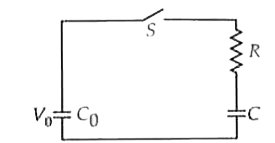A capacitor of capacitance C1=3C is charged to a potential difference V and connected to an unchanged capacitor of capacitance C2=C through a resistor of resistance R and a switch. Switch is turned on at t = 0.

What is the time constant for the charging of C2?
3RC/5
3RC/7
3RC/9
6RC/8
The correct Answer is:D
Here is the circuit diagram showing current and charges on the capacitor in a transient state.

Let q be the instantaneous charge on capacitor C2, then according to charge conservation 3CV−q must be the remaining charge on capacitor C1 because initial charge with the capacitor C1 is 3 CV.
Applying Krichhoff.s law for the loop ADCBA
−qC−iR+3CV−q3C=0
⇒−qC−R+V−q3C=0
⇒V−4q3C=0R
⇒3CV−4q=i(3RC)..(i)
We can write i=dq/dt in equation (1) to get the following
3CV−4q=dqdt3RC⇒dq3CV−4q=dt3RC
⇒q∫0dq3CV−4q=t∫0dt3RC
⇒[−14ln(3CV−4q)]q0=t3RC
⇒ln((3CV−4q))3CV=−4t3RC
⇒(3CV−4q)3CV=e4t3RC
⇒q=3CV4(1−e4t3RC) ...(ii)
Current flowing in the circuit can be calculated by differentiating charge:
⇒i=dqdt=3CV4(0+43RCe4t3RC)
⇒i=VRe4t3RC...(iii)
The rate of heat generation across resistance as a function of time can be written as follows:
H=i2R
⇒H=V2Re8t3RC...(iv)
Topper's Solved these Questions
- BOOK - MODERN PUBLICATIONCHAPTER - CURRENT ELECTRICITYEXERCISE - Objective Type Questions (MULTIPLE CHOICE QUESTIONS) (D. MULTIPLE CHOICE QUESTIONS ASSERTION REASON TYPE QUESTIONS)10videos
CURRENT ELECTRICITY
- BOOK - MODERN PUBLICATIONCHAPTER - CURRENT ELECTRICITYEXERCISE - Objective Type Questions (MULTIPLE CHOICE QUESTIONS) (D. MULTIPLE CHOICE QUESTIONS MATRIX MATCH TYPE QUESTIONS)1videos
CURRENT ELECTRICITY
- BOOK - MODERN PUBLICATIONCHAPTER - CURRENT ELECTRICITYEXERCISE - Objective Type Questions (MULTIPLE CHOICE QUESTIONS) (C. MULTIPLE CHOICE QUESTIONS WITH MORE THAN ONE CORRECT ANSWER)18videos
CURRENT ELECTRICITY
- BOOK - MODERN PUBLICATIONCHAPTER - ATOMS EXERCISE - Chapter Practice Test16videos
ATOMS
- BOOK - MODERN PUBLICATIONCHAPTER - DUAL NATURE OF RADIATION AND MATTER EXERCISE - CHAPTER PRACTICE TEST15videos
DUAL NATURE OF RADIATION AND MATTER
Similar Questions
A capacitor of capacitance C1 is charged to a potential difference V and then connected with an uncharged capacitor of capacitance C2 a resistance R. The switch is closed at t = 0. Choose the correct option(s):
View SolutionA capacitor of capacitance C0 is charged to potential V0. Now it is connected to another uncharged capacitor of capacitance C02. Calculate the heat loss in this process.
View Solution
Knowledge Check
- Question 1 - Select One or More
A capacitor of capacitance C1 is charged to a potential difference V and then connected with an uncharged capacitor of capacitance C2 a resistance R. The switch is closed at t = 0. Choose the correct option(s):
AThe initial current through the resistance is VRBThe current through the resistance as a function of time is i(t)=VRe−tτ where τ=R(C1C2C1+C2)CThe charge on capacitor C1 as a function of time is q1(t)=(C1VC1+C2)(C1+C2e−tτ)DAfter a long time, the potential difference across the capacitor C1is(C1C1+C2)V - Question 2 - Select One
A capacitor of capacitance C0 is charged to potential V0. Now it is connected to another uncharged capacitor of capacitance C02. Calculate the heat loss in this process.
A12C0V20B13C0V20C16C0V20D18C0V20 - Question 3 - Select One
A capacitor or capacitance C1 is charge to a potential V and then connected in parallel to an uncharged capacitor of capacitance C2. The fianl potential difference across each capacitor will be
AC1VC1+C2BC2VC1+C2C1+C2C1D1−C2C1
A capacitor ' "c'" is charged to a potential "difference "V" and then it is connected to an uncharged capacitor of capacitance "'3c'." Now total loss is "(3(β−1)cv2)" .The value of "β" is "]
View SolutionA capacitor or capacitance C1 is charge to a potential V and then connected in parallel to an uncharged capacitor of capacitance C2. The fianl potential difference across each capacitor will be
View SolutionA capacitor or capacitance C1 is charge to a potential V and then connected in parallel to an uncharged capacitor of capacitance C2. The fianl potential difference across each capacitor will be
View SolutionA charged capacitor of capacitance C is discharging through a resistor of resistance R. At what time the charge on the capacitor is equal to one half of its initial value?
View SolutionA capacitor of capacitance C0 is charged to a potential V0 and is connected with another capacitor of capacitance C as Shown . After closing the switch S, the common potential across the two capacitors becomes V . The capacitance C is given by
 View Solution
View Solution
